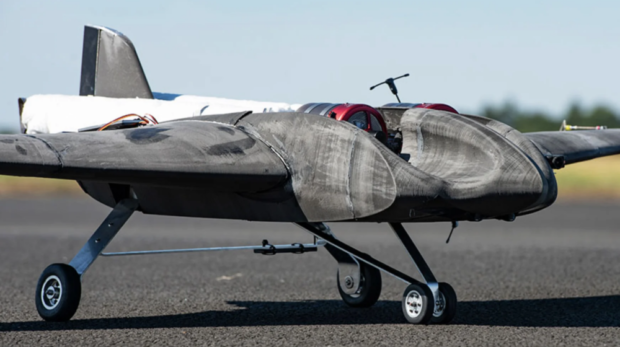In an until-now secretive program, the United Kingdom has rapidly developed and flight-tested a number of “complex” drones that would be suitable for use by Ukraine in its conflict with Russia. While it’s unclear which of any of the unmanned aircraft systems (UAS) in question were ultimately selected for supply to Ukraine, it’s obvious that a range of different capabilities was explored in the process, including surveillance drones and, most intriguingly, what is described as a “3D-printed delta-wing ‘suicide’ drone.”
Some details of the rapid development program were recently revealed by QinetiQ, the U.K.-based defense technology company that works closely with the U.K. Ministry of Defense, especially on experimental projects and novel technologies. The drone program originated in the Future Capability Group — part of the defense ministry’s Defense Equipment and Support (DE&S) branch — which, in turn, engaged QinetiQ.
A statement from QinetiQ doesn’t confirm when the program actually took place, while an uncaptioned accompanying photo shows a small drone with swept wing and tail fin, apparently powered by a pair of micro-turbine engines, and possibly 3D-printed. The suggestion is that this is one of the prototypes from the program, but that also remains unconfirmed for now. On both counts, we have approached the company to find out more.
The aim of the program was to “provide recommendations for uncrewed aircraft systems that could be deployed readily by the Ukrainian military” and was part of a wider U.K. government effort, known as KINDRED, that’s assessing what kinds of weapons and equipment could potentially be introduced to service by Ukraine in the space of just four months.
Within “a few weeks,” according to QinetiQ, it was determined that the drone program would be run from the company’s sprawling MOD Boscombe Down test site, in southwest England. Here, efforts were made to set up a safe and effective “sandbox window” test environment on the airfield.
But while KINDRED explores potential new defense equipment for Ukraine that can be brought to the front line within four months, the drone program was run on a much more demanding timeline. Within just three weeks, the QinetiQ-led team was to demonstrate a series of new drones and related technology to senior U.K. Ministry of Defense officials, during a two-day event. This would include “flying experimental UAS and EW [electronic warfare] testing.”
Ultimately, the defense ministry officials observed equipment, systems, and technologies from five different companies that were demonstrated at Boscombe Down. According to QinetiQ, the test projects “included C2 [command and control] and sensor payload[s] as well as VTOL [vertical takeoff and landing] UAS and a unique 3D-printed delta-wing ‘suicide’ drone.” No details of other projects were disclosed and the companies involved have not been named.
We do know, however, that there was close involvement from a range of U.K. defense organizations and units, including the Royal Air Force (RAF) Rapid Capabilities Office (RCO), the Royal Navy, the RAF’s No. 56 Squadron, Royal Artillery, Defense Science and Technology Laboratories (DSTL), U.K. Strategic Command, and the British Army HQ, as well as the Future Capability Group and DE&S.
As well as flight tests of at least some of the rapidly developed drones, the trials also included experiments on the ground, and use was also made of Boscombe Down’s anechoic test facility, which can be used to assess how test specimens respond to radio-frequency energy, as well as providing a controlled environment to see how electronic systems and emissions interact with one another. The anechoic chamber was also used to expose the test specimens to command link jamming, an important consideration in Ukraine considering Russia’s widespread use of offensive electronic warfare.
Source: The Drive

